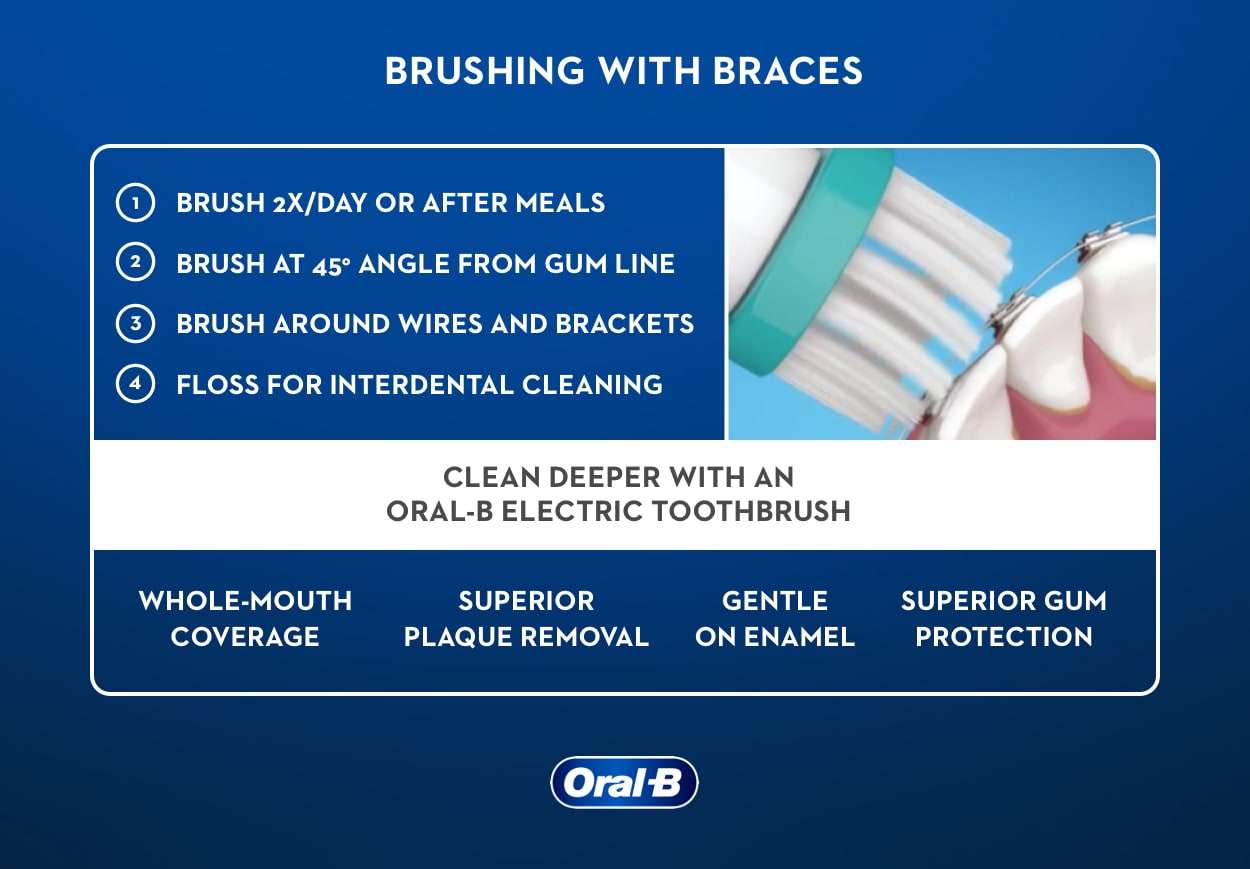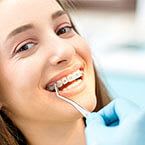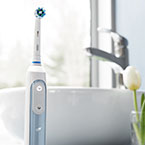HOW TO BRUSH YOUR TEETH AND FLOSS WITH BRACES

- Dealing with Plaque Around Your Braces
- Take Care of Your Gums After Braces with Electric Toothbrushes
- Brushing with Braces
- Flossing With Braces
- Plan Regular Checkups
- How to Take Care of Your Child’s Braces
If you or someone in your family wears braces, take heart. Before you know it, you’ll be flashing a confident smile if you keep these few things in mind.
Once teeth are straightened by braces, it is easier to reach plaque on and between your teeth. But while wearing braces, plaque and food particles have additional places to accumulate and become trapped. Use an Oral-B® Electric Toothbrush with an Ortho® or Power Tip brush head that’s specially designed to effectively and gently clean around braces.
Be prepared to spend three times as long on your oral care while you have braces on your teeth. Don't worry, it's worth the time. If you don't pay attention to oral hygiene while your teeth are being realigned, you increase your risk of gum disease. Plus, it can help your teeth look that much better when it's finally time to get your braces removed.
Take Care of Your Gums After Braces with Electric Toothbrushes
While wearing braces, you might consider using the sensitive mode of your Oral-B Electric Toothbrush. The sensitive mode oscillates at a lower speed for extra care and comfort along the gum line—and around the brackets and orthodontic wires.
Brushing with Braces
Using an Oral-B Electric Toothbrush makes this routine easy.
- Get started: Remove elastics, bands, or removable parts of orthodontic appliances.
- Clean your braces: Carefully clean around wires and pins.
- Brush each wire: Move top to bottom, and all the way around upper and lower teeth.
- Brush your teeth: Dental professionals recommend brushing your teeth for two minutes, twice daily. That means each quadrant of your mouth gets 30 seconds. The Oral-B iO Electric Toothbrush features AI Recognition and 3D Tracking to help ensure you’re covering all the areas of your mouth, including tooth surfaces.
- Rinse, and then check your teeth: Rinse thoroughly. Examine teeth and braces in the mirror, and remember to look for any remaining food particles.
Flossing With Braces
Although flossing with braces is tricky, you can get the hang of it with practice if you follow these steps:
- Floss once a day: Use waxed floss (unwaxed floss is more likely to get caught and shred in your braces), dental tape or a product specifically designed to clean around your braces. Use waxed floss and thread it carefully under the main wire before passing between two teeth. Don’t snap it—simply move up and down gently, remove, and move on to the next pair of teeth. Use Oral-B Superfloss®, which is self-threading or regular floss with a floss threader to place above and below the orthodontic wire.
- Use enough: About 18 inches of floss should suffice
- Thread it carefully: Take the floss and carefully thread it under the main wire of the braces before passing it between two teeth. Then remove the floss and re-thread it under the main wire to pass between the next pair of teeth
- Be sure not to snap the floss - simply move it up and down gently against the side of each tooth
Parents: Do the flossing for younger children who lack the coordination to thread the floss under the main wire of their braces.
Plan Regular Checkups
Seeing your orthodontist for checkups and adjustments is essential. He or she can repair broken pieces, answer general questions, and address any irregularities such as cavities or every meal or snack if you wear braces. And some dentists recommend a fluoride mouthwash to help control plaque buildup in the places that are tough to reach with a toothbrush.
How to Take Care of Your Child’s Braces
Do you have a child with braces? The following points will help make your child's daily brushing routine effective:
- Before brushing - Your child should take off elastics and any other removable parts of their orthodontic appliance. For removable appliances, take them out after every meal for cleaning.
- Brush teeth - They should clean each tooth individually. An Oral-B Kids Electric Toothbrush is perfect for growing mouths 3 years and up, and features their favorite Disney characters to help encourage good oral hygiene habits. First, they should place their brush at a 45-degree angle from the gum line, then apply gentle pressure whilst moving in a circular motion. They should do this for about 10 seconds, using the same brushing action on all outer and inner tooth surfaces, and tilting the brush as needed to better reach the insides of smaller front teeth.
Most Advanced For Healthy Gums During and After Braces
662
- Clean the braces - Your child should hold the brush at a 45-degree angle to clean around the wires and brackets of their braces. They need to brush from the top of each wire down to the bottom. They should take the time to ensure that all plaque and debris is removed, and that they work all the way around upper and lower teeth. For removable braces, clean them over a sink filled with water. This helps to prevent damage to the brace if you accidentally drop it. Brush the brace with a toothbrush and fluoride toothpaste to remove all food and debris. Be careful not to damage the wires. Once it's clean, put the brace back in the mouth.
- Interdental brushes once a day - Have their dental professional show them the best way to clean between the teeth and braces. Also, they should follow the instructions on the product package. They may also want to use an interdental product designed for braces and orthodontic work, like a single-tufted toothbrush or floss.
- Protecting your child's teeth – Braces put their teeth at greater risk of developing decay, therefore they need to keep their teeth strong by using fluoride toothpaste. Brushing should be undertaken twice a day at a minimum and preferably after every meal.
- Fluoride concentration - If their dentist or orthodontist feels they are at greater risk of tooth decay, they may increase the fluoride concentration by (i) prescribing a stronger toothpaste, (ii) applying fluoride varnish to their teeth two to four times a year when they visit them or (iii) asking them to use a fluoride mouthwash at a different time than tooth brushing.
- Spit, but do not rinse after brushing – Rinsing after brushing will wash away the fluoride toothpaste which is needed to strengthen their teeth. This dilution effect is why even a mouthwash straight after brushing is bad news as it dilutes the fluoride around their teeth.
- Keep up regular visits with their dentist and orthodontist.





